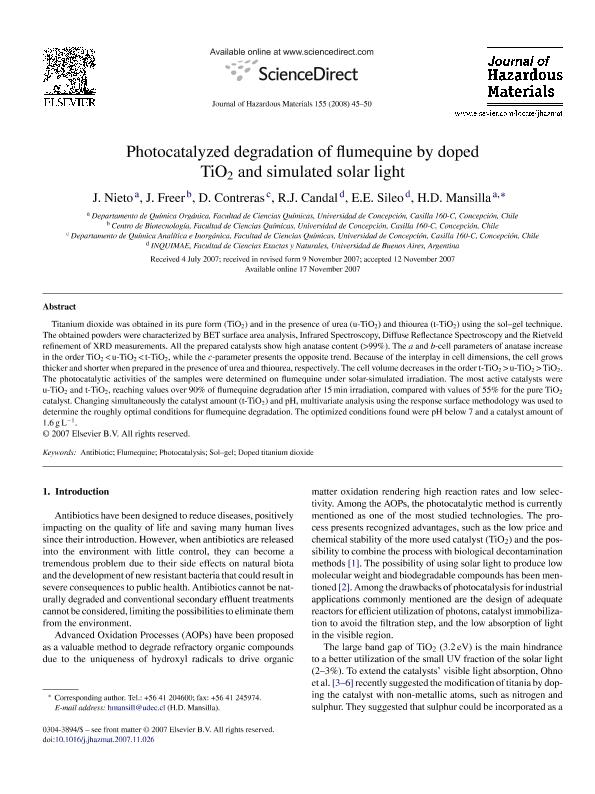Artículo
Photocatalyzed degradation of flumequine by doped TiO2 and simulated solar light
Fecha de publicación:
06/2008
Editorial:
Elsevier Science
Revista:
Journal of Hazardous Materials
ISSN:
0304-3894
Idioma:
Inglés
Tipo de recurso:
Artículo publicado
Clasificación temática:
Resumen
Titanium dioxide was obtained in its pure form (TiO2) and in the presence of urea (u-TiO2) and thiourea (t-TiO2) using the sol-gel technique. The obtained powders were characterized by BET surface area analysis, Infrared Spectroscopy, Diffuse Reflectance Spectroscopy and the Rietveld refinement of XRD measurements. All the prepared catalysts show high anatase content (>99%). The a and b-cell parameters of anatase increase in the order TiO2 < u-TiO2 < t-TiO2, while the c-parameter presents the opposite trend. Because of the interplay in cell dimensions, the cell grows thicker and shorter when prepared in the presence of urea and thiourea, respectively. The cell volume decreases in the order t-TiO2 > u-TiO2 > TiO2. The photocatalytic activities of the samples were determined on flumequine under solar-simulated irradiation. The most active catalysts were u-TiO2 and t-TiO2, reaching values over 90% of flumequine degradation after 15 min irradiation, compared with values of 55% for the pure TiO2 catalyst. Changing simultaneously the catalyst amount (t-TiO2) and pH, multivariate analysis using the response surface methodology was used to determine the roughly optimal conditions for flumequine degradation. The optimized conditions found were pH below 7 and a catalyst amount of 1.6 g L-1.
Palabras clave:
Antibiotic
,
Doped Titanium Dioxide
,
Flumequine
,
Photocatalysis
,
Sol-Gel
Archivos asociados
Licencia
Identificadores
Colecciones
Articulos(INQUIMAE)
Articulos de INST.D/QUIM FIS D/L MATERIALES MEDIOAMB Y ENERGIA
Articulos de INST.D/QUIM FIS D/L MATERIALES MEDIOAMB Y ENERGIA
Citación
Nieto, J.; Freer, J.; Contreras, D.; Candal, Roberto Jorge; Sileo, Elsa Ester; et al.; Photocatalyzed degradation of flumequine by doped TiO2 and simulated solar light; Elsevier Science; Journal of Hazardous Materials; 155; 1-2; 6-2008; 45-50
Compartir
Altmétricas




